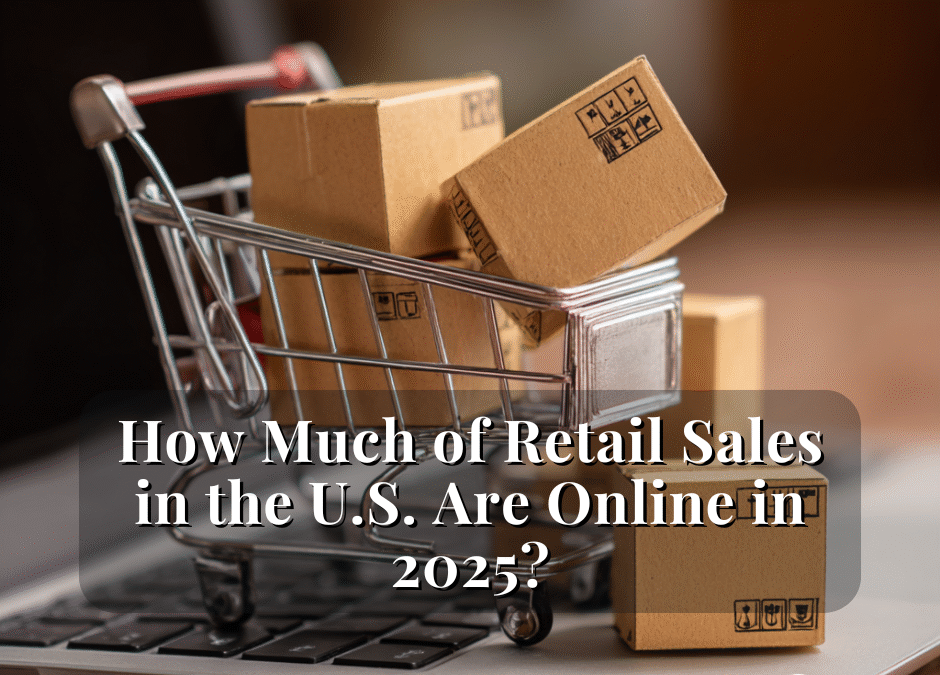As of mid-2025, e-commerce accounts for approximately 16.3% of total U.S. retail sales, according to the U.S. Census Bureau’s most recent quarterly report. That means about one in every six retail dollars in the United States is now spent online.
Understanding the 16.3% Figure
The U.S. Census Bureau releases official data on retail e-commerce sales each quarter.
- Q2 2025 estimate: $296.2 billion in online sales
- Total retail sales: $1.82 trillion
- E-commerce share: 16.3%
These numbers are seasonally adjusted, meaning they account for predictable spikes like holiday shopping. The share typically increases slightly in Q4 each year when consumers shop heavily online.
Year-Over-Year Growth
E-commerce continues to grow faster than in-store retail. Compared with the same quarter in 2024:
- Online sales rose about 7.5%
- Total retail sales rose about 2.3%
That growth rate shows steady, sustainable expansion rather than the rapid surges seen during the pandemic years. Analysts note that mobile shopping and faster delivery logistics remain key growth drivers.
Why This Statistic Matters
- Economic indicator: The e-commerce share helps economists and investors measure how quickly consumers are shifting to digital shopping.
- Business planning: Retailers use this ratio to guide digital investments, warehouse capacity, and advertising spend.
- Marketing and SEO: Knowing how much traffic and sales originate online helps allocate resources between physical and digital storefronts.
E-Commerce vs. In-Store Retail
While e-commerce growth is strong, in-store sales still dominate more than 80% of the market. Brick-and-mortar remains essential for high-touch categories such as groceries, home improvement, and automotive.
However, the line between online and offline is blurring. Many purchases now start online but finish in a physical store, or vice versa. Analysts often refer to this hybrid model as “omnichannel retail.”
How the U.S. Compares Globally
Globally, the e-commerce share of retail is higher in several markets:
- China: Over 30%
- United Kingdom: Around 25%
- United States: 16.3%
The difference largely reflects population density, logistics efficiency, and consumer trust in online payments. The U.S. is catching up slowly as mobile checkout and same-day delivery become standard.
Expert Insight: Why Growth Appears Slower Now
After the pandemic-driven boom in 2020-2021, growth normalized. The base of online shoppers is now larger, so percentage increases appear smaller. Factors influencing growth today include:
- Rising shipping costs
- Competition among major marketplaces
- Inflation-driven changes in consumer spending
- Increased adoption of “buy online, pick up in store” (BOPIS) models
Reliable Source for U.S. E-Commerce Data
The U.S. Census Bureau’s “Quarterly Retail E-Commerce Sales” report is the primary source journalists and analysts cite. It is published about six weeks after each quarter ends and includes both adjusted and unadjusted estimates.
You can access the current and historical data directly at:
https://www.census.gov/retail/ecommerce.html
Quick Facts Summary
| Metric | Q2 2025 | Change from Q2 2024 |
|---|---|---|
| Total U.S. retail sales | $1.82 trillion | +2.3% |
| E-commerce sales | $296.2 billion | +7.5% |
| Online share of retail | 16.3% | up from 15.5% |
FAQ: U.S. E-Commerce Share of Retail Sales
1. What percentage of U.S. retail sales are online right now?
As of the second quarter of 2025, e-commerce represents about 16.3% of total U.S. retail sales.
2. Who provides official U.S. e-commerce data?
The U.S. Census Bureau publishes quarterly estimates based on a nationwide sample of retailers.
3. How often is this number updated?
Every quarter, roughly six weeks after each quarter ends.
4. Why does the percentage change by quarter?
Online shopping spikes in the fourth quarter due to holiday sales and promotions, then falls slightly in the first quarter.
5. Has e-commerce reached a plateau?
Growth has slowed compared with the pandemic years, but online sales are still increasing faster than total retail sales overall.
6. What is the difference between “e-commerce” and “total retail”?
E-commerce covers orders placed online or through mobile apps, while total retail includes both online and physical store transactions.
7. Does mobile shopping count toward e-commerce?
Yes. Purchases made through mobile browsers or retail apps are included in e-commerce totals.
8. How does the U.S. compare to other countries?
The U.S. lags behind markets like China and the U.K., where online shopping already makes up 25–30% of retail.
9. What industries drive most online sales?
Apparel, electronics, and general merchandise dominate online categories, while groceries and furniture are catching up.
10. What should businesses do with this data?
Use it to benchmark digital performance, plan marketing budgets, and align operations with consumer buying habits.


Recent Comments